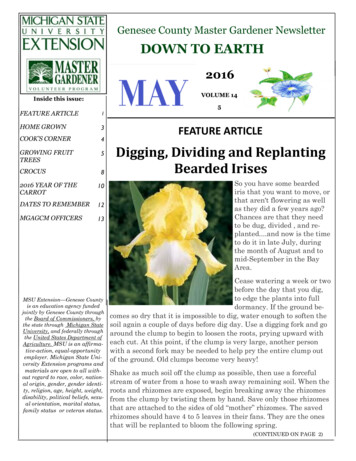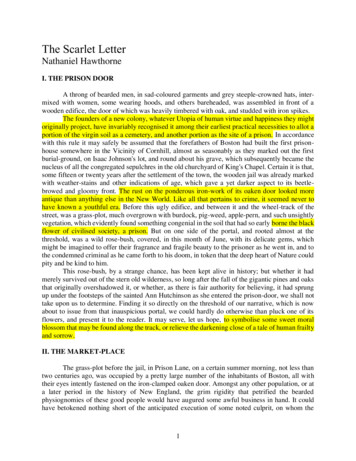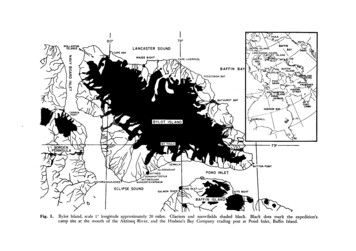
Transcription
Genesee County Master Gardener NewsletterDOWN TO EARTH2016Inside this issue:FEATURE ARTICLE1HOME GROWN3COOK’S CORNER4GROWING FRUITTREES5CROCUS82016 YEAR OF THECARROT10DATES TO REMEMBER12MGAGCM OFFICERS13MSU Extension—Genesee Countyis an education agency fundedjointly by Genesee County throughthe Board of Commissioners, bythe state through Michigan StateUniversity, and federally throughthe United States Department ofAgriculture. MSU is an affirma-tive-action, equal-opportunityemployer. Michigan State University Extension programs andmaterials are open to all without regard to race, color, national origin, gender, gender identity, religion, age, height, weight,disability, political beliefs, sexual orientation, marital status,family status or veteran status.FEATURE ARTICLEDigging, Dividing and ReplantingBearded IrisesSo you have some beardediris that you want to move, orthat aren't flowering as wellas they did a few years ago?Chances are that they needto be dug, divided , and replanted.and now is the timeto do it in late July, duringthe month of August and tomid-September in the BayArea.Cease watering a week or twobefore the day that you dig,to edge the plants into fulldormancy. If the ground becomes so dry that it is impossible to dig, water enough to soften thesoil again a couple of days before dig day. Use a digging fork and goaround the clump to begin to loosen the roots, prying upward witheach cut. At this point, if the clump is very large, another personwith a second fork may be needed to help pry the entire clump outof the ground. Old clumps become very heavy!Shake as much soil off the clump as possible, then use a forcefulstream of water from a hose to wash away remaining soil. When theroots and rhizomes are exposed, begin breaking away the rhizomesfrom the clump by twisting them by hand. Save only those rhizomesthat are attached to the sides of old “mother” rhizomes. The savedrhizomes should have 4 to 5 leaves in their fans. They are the onesthat will be replanted to bloom the following spring.(CONTINUED ON PAGE 2)
DOWN TO EARTHPAGE 2(CONTINUED FROM PAGE 1)NOTE: Once a rhizome has bloomed, that rhizome will not bloom again. Only the “increase”rhizomes that grow along the edges of the “mother” rhizome will bloom, so save the “increase”.Discard all the other rhizomes and leaves by placing in the curbside trash can. Do NOT compost iris plants.How can a “mother” rhizome be recognized? It may have a bloom stalk still attached. Or it mayhave a small, round, smooth callus, about the size of a thumbnail, at the leaf fan end where thebloom stalk was attached. It probably will have from one to three new rhizomes with their leaffans growing off of it. Select the largest size “increase” rhizomes to replant. Trim their leavesto 8 or 10 inches before replanting. And this is the only time to trim leaves. Do NOT trimleaves of plants that will stay in the ground from one year to the next. Then hold the roots ofthe rhizome in one fist and trim off the long roots below your fist.If the name of the cultivar that you have dug is known, use a Sharpie pen to write that nameon the central leaf of each fan. This will stay on the plant through washing, drying, and replanting ONLY. It will NOT stay on permanently. Now lay the “keeper” rhizomes aside in ashaded location, a garage or cool shed is a good storage area, while the planting beds or planting holes are readied. It will not damage the prepared rhizomes to remain out of the ground fortwo weeks.Select a planting location with good drainagethat receives a minimum of 5 to 6 hours of sunevery day or that is in full sun. Iris may beplanted in a bed or as clumps between otherplants. Prepare the planting areas by diggingat least 12” deep and 2 feet across. Add 1/3 theamount of compost as soil, and a handful of acomplete fertilizer with all three numbers thesame, such as 12-12-12, for each rhizome thatwill be planted in the hole. Iris are very heavyfeeders. Mix soil and amendments and leavefor a week or two, if possible, prior to replanting. The “wait” time is not mandatory, justgives the mixture time to mature.Just prior to replanting, submerge the rhizomes and leaves in a solution of 1 part Cloroxto 10 parts of cool water for about 20 minutes.Rinse thoroughly with running water, and allow to dry off in the sun. . This washing tells therhizome to break dormancy and start growing again. It will also tend to prevent most fungaldiseases.For an instant clump, plant three rhizomes of the same variety together. Imagine a large clockface. Leaving an 8 inch circle in the middle of the clock face, plant a rhizome at 12 o'clock (leaffans at the perimeter of the 8” circle, rhizomes pointing toward the outer perimeter of the clockface), plant another rhizome at 4 o'clock, and the third rhizome at 8 o'clock. Cover the rhizomeswith soil, leaving the upper surface of each rhizome even with the soil level.(CONTINUED ON PAGE 9)
DOWN TO EARTHPAGE 3HOME GROWN 847I am associated with a youth group that is interested in learning about vegetable gardening year-round. I don’t know anything about plants but I am assured that peoplein Michigan can do this outside throughout the winter. All you need to do is to tentthe area with clear plastic and plants will grow. I want to get the kids growing plantsfor food. How do we start?In very simple terms, you don’t. It is too cold to grow herbaceous plants during the winter inMichigan. Herbaceous plants are those that die to the ground when the weather drops to 32 degrees. Perennial plants will regrow from the roots in the spring. The tops have cell walls in theleaves and stems that explode from freezing. For plants that are called annuals, the roots alsodie. Covering plants with a plastic tent will protect against light frosts but not hard freezes.There’s also the problem of the soil becoming too cold for seeds to germinate and plants to grow.If you look at cool season vegetables like peas, carrots and cabbage, the soil temperature needsto be above 40 degrees to even survive. But that’s not growing. The desired or optimum soil temperature is 75 to 85 degrees. That’s when plants grow and get big enough to harvest. And warmseason vegetables like tomatoes, corn and beans need an optimum soil temperature of 85 to 95degrees which is hotter than your house is in the winter. This means that you cannot get seedsto germinate or transplants to stay alive. Every time you lift that plastic cover, the air temperature drops rapidly. There’s also the problem of no sun to warm the trapped air at night or onmany cloudy days. Michigan has the third highest amount of cloud cover of all the states. Somepeople grow plants in heated greenhouses but the house and the heater raise the cost of growingvegetables. During the late fall, winter and early spring, the earth has tipped away from the sunfor us in the Northern Hemisphere. There are not enough hours of direct, strong light to growflavorful vegetables. You may want to learn about growing plants if your goal is to help the kids.You can’t teach if you don’t know the information and applied it.What kind of flowers will grow in clay soil? I have tried to get plants to grow and theyjust die. I have a small round garden bed and the dirt between the plants hardens upso much that water just runs off. Tell me which plants to buy.This isn’t about the plants; it’s about the soil. For small plants, it is possible to change the soilwhere they are growing. If you are talking about trees and shrubs, it is impractical to alter hugeareas without heavy equipment and lots of cash. Clay is made up of tiny soil particles that areflat and stack tightly on top of each other. The goal will be to dig up the clay and mix it withcompost or composted manure to break up the compaction. If you are able to dig down to 18-24inches in the bed, add compost to the broken-up soil chunks. A good soil is only five percent organic matter so you definitely do not want to try to fifty-fifty the mix. That’s excessive. The goalis to dig deeper than the depth of the roots of plants that will grow there. This gives a place forwater to pass by roots and collect in big rain events. Try to break the clay into marble or peasized pieces. You don’t want golf ball pieces with compost between them. Now, do the smartthing and get a soil test to find out if there are nutrient deficiencies or soil pH problems. You canpurchase one online or at MSU Extension for 25. Online, go to: www.msusoiltest.com to purchase a test. After putting in plants, mulch between them with three inches of something organic like wood chips, straw or shredded leaves. This and the organic matter that is now in the soilwill prevent hardening. Mulch will help prevent weed seeds from germinating and you don’thave to water as often because top evaporation will be limited because of the soil cover.Gretchen Voyle, MSU Extension-Livingston County Horticulture Educator 517/546-3950
DOWT OT OE AD ONWNE ARRTTHPAGEPAGE4COOKS CORNERPEANUT BUTTER CAKE2 sticks of butter or oleo1 cup of water½ cup of peanut butterBring to a boil. Remove from the heat.Add:2 cups of flour2 cups of sugar2 eggs½ tsp salt½ cup of sour cream1 tsp. of baking sodaStir together. Mixture will be thick. Pour in a 10 x 15 prepared pan. Bake 25-30 minutes.Frosting:1 stick of butter or oleo1/3 cup of milk½ cup peanut butterBring to a boil. Add: 1 tsp. of vanilla and 1 box of xxx sugar (confectioners). Beat untilsmooth. Frost hot cake.Jo Ann Zitterkopf ‘03Please NoteWe are unable to provide you with last months meeting minutes from the Annual Banquet. Itseems a masked man with an Indian companion absconded with the meeting notes. Theywere last seen exiting the building and mounting a white horse. The masked man was heardto say, Hi Ho Silver as the pair vanished into the night. Ed.(Meeting minutes will be available at May’s general membership meeting)4
VOLUME 14PAGE 5DOWN TO EARTHGrowing Fruit Trees: Why Size MattersWhen growing fruit trees, you would think bigger is better. If you buy a bigger trees you’ll getto enjoy you harvest sooner, right? If you let your tree grow larger, you will get enough fruit tomake lots of pies.Actually. Size does matter when it comes to growing fruit trees. But the truth is that smallertrees are much better. They are easier to care for and they are healthier. Yes, they will produce less fruit, but that fruit will be sweeter and easier to harvest.So how can you keep your fruit trees compact, productive and healthy? There are two keyways. One is by buying the right trees. The other is by using the correct annual pruning techniques.Buying the Right TreeWhen you go to the garden center to buy your tree, you don’t really have much of a choice.They will have a few fruit tree cultivars and all of those trees will be potted, ready to plant inyour yard whenever you are.When you order fruit trees from a specialist fruit tree nursery, however, it’s a completely different experience, You will have a wide range of cultivars to choose from, so you can researchand select a tree that will thrive in your conditions. After you choose and order your tree, itwill be shipped to you, but not right away. That’s because specialist fruit tree nurseries selltheir trees “bare root”. They dig their trees out of the ground in the early spring and sendthem to you at that time.The trees you receive may be a whip — a year-old tree that looks like a tiny twig with roots —or it may be a slightly larger. Two or three year old tree. Either way, it comes to you with itsvulnerable bare toots wrapped in moist sawdust or newspaper. The tree, still dormant, cansurvive like this for only a few days, So after it arrives, your tree must be planted immediately. If you see the buds are starting to burst, it’s a sign that planting quickly is essential, If abare-root tree emerges from dormancy before being planted. It will become stressed and die.Planting a bare-root tree can feel like a game of “beat the clock”, so it is really worth the hassle? The answer is a resounding “Yes”. Bare-root fruit trees adapt more readily to their newenvironment. They grow more quickly once they are in the ground. They are healthier thanposted trees. And they are easier to shape into an ideal fruit-supporting structure throughcored annual pruning.Controlling Tree Size with Correct Annual PruningThere are so many reasons to keep your fruit tree small. Here are a few of them:Fruit trees can grow to be taller than houses. Cherry trees are notorious for being vigorousgrowers, but even apple and pear trees can grow to be huge. And who but the birds can enjoythe fruit at the top of the tree?Big trees can cause a lot of mess as ladder-fearing gardeners wait until the fruit falls to theground. By that time it’s soft, half rotten and unappealing. Who wants to use squishy bird—pecked or wormy apples in their fruit crumble?(CONTINUED ON PAGE 6)
VOLUME 14DOWN TO EARTHPAGE 6(CONTINUED FROM PAGE 5)Big trees are hard to care for. Even if you grow your fruit organically, you do have to spraythem from time to time with organic sprays. It’s hard to spray a large tree.All fruit trees need pruning to ensure good air circulation and to give all the branches equalaccess to light. Pruning is much more difficult to do when you have a really big tree.If you’re interested in large, sweet fruit, rather than smaller fruit that’s as hard as a rock,you need to do some hand thinning on your trees. Plucking off some to be baby fruit early inthe season so that the remaining fruit has room to grow to full size. Who is going to handthin the fruit on the upper branches of your oversized tree?I could go on and on, but by now your get the picture. Smaller trees are better, and if youkeep your tree small — anywhere from 7 to 12 feet tall — you’ll have room for other plantsyour garden too. You might even have room for a couple more fruit trees.So . What’s the secret? How do you keep your tree small? Here are a couple of options:Some people control the size by selecting and planting a tree that has been grafted ontodwarfing rootstock. That is certainly one option, but trees grown on dwarfing root stock areoften weak and need staking.Or you can get a book or go online and learn fruit tree pruning skills. Correct pruning helpsyou create a strong but compact fruit—bearing structure for your tree. It also improves aircirculation and ensures that all branches have full access to the sun.Your pruning adventure starts on the first day youplant your bare—root tree, when you perform a “whipcut”, slicing off the top third of the tree to spur vigorous growth and encourage the tree to focus its energyon its root system. Each year after that shape yourtree using your hand pruners or loppers. To encouragevigorous growth, you can prune young trees in the early spring while they are dormant.Once your tree has reached an appropriate size, youmay opt for summer pruning. That way, you can reduce the size of the tree or the length of the brancheswithout spurring tons of new growth during the growing season. Your fruit tree will still grow, just not asmuch. Which is good if you want to keep it small.What If You Already Have a Large Tree?If you have a tree that’s grown too large, you can bringits size down slowly over a number of years. Each 7 years, you can sagely remove up to 20%of the branches on you tree. If you take off more, you will stress your tree and possibly kill it.Renovating a larger tree can take four to five years. Ultimately, it’s worth it as you alreadyhave a tree that’s established and producing a harvest for you, whereas newly planted fruittrees can take five years to start producing a harvest .(CONTINUED ON PAGE 7)
DOWN TO EARTHPAGE 7(CONTINUED FROM PAGE 6)Developing a RelationshipFruit—tree pruning is very different from pruning native or ornamental trees, and there aresome skills you will need to learn. But once you know the theory behind correct pruning , it iseasy.What you will find over time is that asyou prune and care for your tree, youwill develop a relationship with it.You’ll see how it responds to the previous years’ cuts. It will teach you how itwants to be shaped and cared for.For me that is the magical, challengingand enjoyable part of fruit tree care. Ihope you will enjoy it too.Text and photos by Susan PoiznerSWEET AND FUNNY GARDEN SIGNS
VOLUME 13DOWN TO EARTHCrocusPhoto Gita WrightText WikipediaPAGE 8About 30 of the species are cultivated, including Crocus sativus for saffron production. The varieties cultivated for decorationmainly represent five species: C. vernus, C.chrysanthus, C. flavus, C. sieberi, andC. tommasinianus. Among the first flowersto bloom in spring, crocuses are popularwith gardeners. Their flowering time varies from the late winter C. tommasinianusto the later large hybridized and selectedGiant "Dutch crocuses" (C. vernus). Crocusflowers and leaves are protected from frostby a waxy cuticle; in areas where snow andfrost occasionally occur in the early spring,it is not uncommon to see early floweringcrocuses blooming through a light latesnowfall.Most crocus species and hybrids should beplanted in a sunny position, in gritty(sandy), well-drained soil, although a fewprefer shadier sites in moist soil. Some aresuitable for naturalizing in grass. Thecorms should be planted about 3 to 4 cmdeep; in heavy soils, a quantity of sharpgrit should be worked in to improve drainage.Some crocuses, especially C. tommasinianus and its selected forms and hybrids (such as 'Whitewell Purple' and'Ruby Giant'), seed prolifically and are ideal for naturalizing. They can, however, become weeds in rock gardens, where theywill often appear in the middle of choice,mat-forming alpine plants, and can be difficult to remove.
VOLUME 14DOWN TO EARTHPAGE 9CONTINUED FROM PAGE 2 )DO NOT PLANT DEEP ! Plant clumps no closer than four feet center to center, individual rhizomes no closer than 24 inches apart. Bearded iris can stay in the original planting spot for 2to 3 years before the gardener has to dig and divide again so they need the extra space to growand increase.If the name of the iris is known, write it with an oil base china marker (available at office supply stores) or label maker tape on a plant marker and place it in the middle of the clump. Narrow Venetian blinds cut into 12” lengths also make inexpensive plant markers. Write thename on the top end & the bottom end of the blind using china marker or label maker, andpush the blind into the soil so that only the upper end of the marker is visible. If the nameshould come off the exposed end, the name will remain clear on the part underground. Makinga planting map with location and names of the iris is also a good idea since markers can getlost or displaced during weeding and other garden work.Water plants deeply to settle them in. Then water only enough to keep the ground moist. Thenew plants will begin to send out new roots immediately. New leaves will begin growing moreslowly at the center of the leaf fan. Old leaves will turn brown and may be pulled off with asideways tug. Keep the area weeded. Continue watering as noted until the fall/winter rainstake over . Too much water or standing water will cause the rhizomes to rot. A drip wateringsystem is best for bearded iris. Overhead watering can lead to leaf spot, a fungal disease thatcauses circular brown spots on the leaves. To control leaf spot, spray before the first rain witha fungicide formulated for iris leaf spot. A second spraying may be needed in early spring asthe weather warms.In February, when plants begin spring growth, feed each clump with one handful per rhizomeof the same complete fertilizer used at planting time. Apply as a side dressing, scratch in, andwater –or side dress and scratch in just prior to a natural rain.At this time keep a sharp eye out for snails and slugs. Hand pick after dark or, for a heavy infestation, review the UC Pest Note on snails and slugs. Fertilize again in the same way afterthe bloom season is over, approximately in late May. Cut off spent blooms stalks at an anglewith a sharp knife or clippers just above the rhizome. Water through the summer for development of larger rhizomes. Keep beds weeded and withered leaves removed from the plants andthe beds. Older varieties may have sentimental value because Grandma had them in her yard,or because they were inherited from a good friend – that probably makes it reasonable to growa clump of each. However, if the idea of having iris bloom in your garden all year long is appealing, or, if the modern, huge, ruffled and laced blossoms are the ones that call your name,go online and search for iris and search for "bearded iris suppliers", you'll find lots more information.By Philippa Alvis, MG ‘07Santa Clara County CaThere may be some climate differences but the technic is thesame, ED
VOLUME 14DOWN TO EARTHPAGE 102016 Is the Year of the CarrotWhile carrots are one of the top 10 most economically important vegetable crops in the world,they also are one of the most popular vegetables to grow in home gardens - and for good reason.Carrots are delicious, nutritious, versatile, and with just a little bit of know-how, this rootcrop is easy to grow.It is “root” to tell a lie: While Vitamin A that is derived from Beta Carotene found in orangecarrots does aid in overall eye health, you won’t be able to have full-fledged night vision fromeating an abundance of carrots, as some have reported.Your skin, however, CAN turn yellow from eating an abundance of carrots! Not to worrythough, the yellowing will go away after a few weeks as long as you cut down on the carrotintake.History:The ancestor to the modern day carrot is believed to have originated in Afghanistan and waspurple, scrawny, and pungent. Over time, cultivation by Greeks and Romans resulted in rootsthat were plumper, tastier, and came in shades of purple, red, and black. It wasn’t until thelate 16 or early 17th century that the orange, appetizing carrots that we know today werebred by the Dutch in Europe.Basic Types:Carrots (Daucus carota) are members of the Apiaceae family, which also includes culinaryplants such as anise, celery, coriander (cilantro), dill, and parsnips. They are biennials, meaning that they will flower in the second year of growth, but are typically grown as annuals(grown and harvested in the same year). There are several different carrot types and theyare primarily divided up by shape.Variety/Series Names:The following are some of the more well-known types, along with their characteristics andlinks to NGB members websites for more information on ordering.Chantenay - Conical, triangular shaped roots with broad shoulders and rounded tips. Sweetflavor makes it good for eating fresh.Varieties include:Royal Chantenay Red Core KurodaDanvers - Cylindrical, thick roots that are often used to make carrot juice due to the highwater content and low sugar content.Varieties include:Danvers Danvers Half Long(CONTINUED ON PAGE 11 )
DOWN TO EARTHPAGE 11(CONTINUED FROM PAGE 10)Imperator - Long, tapered roots with narrow shoulders. These are typically the carrots youwould buy in a plastic bag at the grocery.Varieties include: Sugarsnax 54 Imperator 58 YellowbunchMiniature/Baby - Either small round roots (also called Planet-types) or cylindrical andshort.Myth debunked: Baby carrots that are purchased in a bag at the grocery are actually madefrom long, skinny carrots that have been cut.Varieties include:Atlas Parisian AdelaideNantes - Cylindrical, “cigar-shaped” roots that are sweet and crispy.Varieties include:Purple Haze (All-America Selection Winner) NelsonSuccessful How-To-Grow:Carrots are easy to grow from seed and perform best when directly sown into a garden bedor patio container. National Garden Bureau Members not only provide great products, butalso great growing information.Here are links to some of their websites that help to explain how to grow carrots:Territorial Seed Company Carrot Growing gguide15Johnny's Selected Seeds Carrot Growing Guide - 4 Keys to Carrot paration-spacing-weeding-watering.aspx?source W GrowersLibVegIndex 092015Burpee's How to Plant and Grow Carrots le10646.htmlGardener's Supply Company Grow Carrots In A Grow /7608.htmlThe National Garden Bureau recognizes and thanks Josh Kirschenbaum from PanAmerican Seed as author and contributor tothis fact sheet.This fact sheet is provided as an educational service of the National Garden Bureau. There are no limitations on the use. Pleasecredit the National Garden Bureau.
VOLUME 14DOWN TO EARTH2016 ANNUAL EDUCATIONALMGAGCM BUS TRIPWe have been overwhelmed by the responses that we are getting for this bus trip onThursday, July 21, 2016. The cost is 45.00and we will be visiting Four Star ProvenWinners Display Gardens in Carleton, Mi.,then onto the historic town of Tucumseh toenjoy lunch and just a short distance awaywe will be visiting Hidden Lakes in Tipton,Mi. We will be leaving Flint at 7:30 am andarrive back home by 6:00 pm. The deadlinefor registration is June 1, 2016. You maydownload a registration form at our website:geneseecountymg.org or you can pick up aform at our membership meetings.The Davison Farmers Market starts onMay 7, 2016 and will continue to the lastSaturday in September from 10:00am-until2:00pm. Volunteers are needed for eachSaturday during this time. To sign up for aSaturday call Alan Grove at 810-922-8776.The Grand Blanc Farmers Market willbegin Sunday, May 15th from 10:00am until 3:00pm. We will be there on May 15thand than the first Sunday of each monththereafter. To volunteer for this project callBeth Fromholz-Davis at 810-288-3253 orAlan Grove at 810-922-8776Ask an Master Gardener will begin Saturday, May 7, 2016 including WoJo’s Garden Splendor in Davison, Walkers Nurseryin Burton, Bordine’s in Grand Blanc andCarlson’s Greenhouse in Fenton. If youwould like to volunteer at one of thesenursery’s please call Alan Grove at 810- 922-8776. Volunteer opportunities are Saturdays from 9:00 am-1:00 pm and 1:00 pm to5:00 pm. This project goes thru the end ofMay.PAGE 12DATES TO REMEMBEROn May 19th, 2016 we will be holding ourMGAGCM monthly meeting at theGCCARD building at 605 N. Saginaw St.Flint. Social time will begin at 5:30 pm andour speaker, Marvin Pettway, will begin at 6:00pm. Marvin earned both the Bachelor of Sciencein Forestry and the Master of Forestry degreesfrom the University of Michigan. He hasworked over 40 years in various aspects ofgrounds maintenance including the last 27years as the lead arborist for the UM Ann Arborcampus, Marvin will be speaking with ChrisPargoff on Big Tree Move. Detailing how U of MAnn Arbor transplanted the largest, oldest, wellknown Burr Oak on campus to a new location.Business meeting will follow after a shortbreak. May’s snack providers are LorettaEllwood, Christy Jones, and Alan Groves.We will be holding our June MGAGCMMEETING ON June 16th, 2016 at WoJo’sGarden Splendor at 7360 E Court St. Davison, Mi. We will be meeting at 5:30 pm forsocial time and our speaker from WoJo’s willbegin at 6:00 pm. The presentation will be“Pollinating Plants” and will include non-nativeperennials and annuals that pollinate. After ashort break we will begin our business meeting.This day will also be the first day of our fundraiser. The 2nd day of our fundraiser will bethe following Saturday, June 18th. It allows oursupporters within the general public an entireday to shop for us and fits in fairly well thisyear as the Frost Free dates are so late. So planon coming early and doing some shopping forthose plants you can’t resist and help our membership out at the same time.Bulb Sale will continue in May with the Hotline hours, Monday, Wednesday and Fridaysfrom 8:30 am– 1:00 pm. Bulbs will be available at our May membership meeting on May19th and the sale will end that evening. Thesale has been very successful this year and wethank all who have purchased bulbs to help inthis fundraiser.
DOWN TO EARTHMGAGCM OFFICERS (2015)President810-744-0725Vice r810-659-8014Vicki Laurinlaurinvicki@gmail.comKay McCulloughbirdieball@aol.comDick Moldenhauerrnmold1050@aol.comMichelle Chockleychockleym@gmail.comPAGE 13THIS NEWSLETTER PREPARED BY:Vicki Laurin,laurinvicki@gmail.com. GeorgeRappold, grappocp@att.net, of counsel RuthSimon .CHECK OUT OUR WEBSITESMMGA Inc Website at:www.michiganmastergardener.orgMMGA Inc Facebook Page at:www.facebook.comMichiganMGMGAGCM Website at: Genesee CountyMG.orgMSU Extension-Genesee605 N. Saginaw St. Suite 1AFlint, MI 48502(810) 244-8500Plant & Pest Hotline:(810) 244-8548Hours: Monday, Wednesday and Fridayfrom 8:30 am-1:00pmgeneseeplantpest@anr.msu.eduPublic Office Hours:8 am - 1 pm Monday through Friday.PLANT A BUTTERFLY GARDENMichigan State University Extension programs and materials areopen to all without regard to race,color, national origin, gender, religion, age, disability, political beliefs, sexual orientation, maritalstatus, or family status. MichiganState University, U.S. Departmentof Agriculture and counties cooperating, Michigan State University isan affirmative-action equal opportunity employer. Accommodationsfor persons with disabilities maybe requested. Requests receivedwill be met when possible.
MSU EXTENSION-GENESEE COUNTY605 N. Saginaw St.Suite 1AFLINT, MI 48502www.msue.msu.edu/geneseeAN AFFIRMATIVE ACTION/EQUAL OPPORTUNITY EMPLOYER
In very simple terms, you don't. It is too cold to grow herbaceous plants during the winter in Michigan. Herbaceous plants are those that die to the ground when the weather drops to 32 de-grees. Perennial plants will regrow from the roots in the spring. The tops have cell walls in the leaves and stems that explode from freezing.










